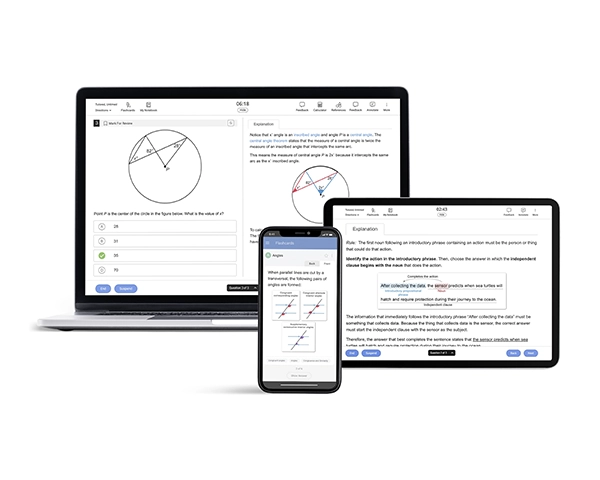Understanding SAT score percentiles is crucial for evaluating your performance relative to other test-takers. Here's an updated breakdown based on the latest data from the College Board®:
- Excellent Score (Top 1%): A score of 1510 or higher places you in the 99th percentile, indicating exceptional performance.
- Good Score (Top 25%): A score of 1150 or higher situates you in the 75th percentile, reflecting above-average achievement.
- Average Score (50th Percentile): Scores between 1000 and 1050 are considered average, positioning you around the 50th percentile.
- Below Average Score (Bottom 25%): A score of 880 or lower places you in the 25th percentile or below, indicating room for improvement.
In the 2024 SATs, a score of 1180 placed students in the 74th percentile, and a score of 1010 placed them in the 49th percentile.1
The criteria for considering an SAT score good include meeting or exceeding the admission requirements of your target colleges, getting placed in the top 75th percentile or qualifying for scholarships and honors programs. Ultimately, it all depends on your personal academic goals. If a score is good enough for you and helps you get into a college of your choice, it is a good SAT score.
While some highly competitive colleges require section scores in the 700-800 range, others have more flexible criteria, often accepting scores in the 500-600 range. Additionally, many colleges adopt a holistic approach to admissions, considering other factors such as GPA, extracurricular activities, personal essays, and recommendation letters, allowing students with lower SAT scores to present a strong application.
Here is a list of 30 colleges that require above-average scores:
| Name of College | Score Range | Name of College | Score Range |
|---|---|---|---|
| Massachusetts Institute of Technology | 1520-1570 | Boston University | 1410-1500 |
| Washington University in St. Louis | 1500-1570 | College of William and Mary | 1365-1510 |
| Duke University | 1520-1570 | Amherst College | 1480-1550 |
| Vanderbilt University | 1500-1560 | Georgia Institute of Technology | 1330-1510 |
| Johns Hopkins University | 1530-1560 | Trinity University | 1290-1440 |
| Princeton University | 1470-1560 | George Washington University | 1320-1460 |
| Yale University | 1500-1560 | Babson College | 1400-1480 |
| Columbia University | 1500-1560 | Rhode Island School of Design | 1390-1520 |
| Brown University | 1470-1550 | Florida State University | 1250-1380 |
| Northeastern University | 1460-1530 | University of Michigan, Ann Arbor | 1350-1530 |
| Georgetown University | 1390-1530 | The College of New Jersey | 1150-1330 |
| Hamilton College | 1430-1520 | Texas Christian University | 1160-1370 |
| Middlebury College | 1440-1530 | Southwestern University | 1180-1320 |
| Washington and Lee University | 1410-1530 | Howard University | 1110-1290 |
| University of Chicago | 1510 - 1560 | Spelman College | 1050-1250 |
| Source: College Board | |||
Reading Your Score Report
Understanding the different sections of the test and how scores are scaled is essential to determining whether you've earned a competitive SAT score. Your composite and section scores are the two most significant aspects that indicate whether your score is good enough to get you into your dream college. Additionally, it's a good idea to consider your percentile rankings, benchmark scores, and how your scores measure up to the averages of the colleges you're interested in. These factors are crucial in assessing your SAT performance.
Figuring out your SAT score report might seem a bit overwhelming with all those numbers and graphs. But don't stress—our blog on how to interpret the digital SAT score report is here to guide you!
How to Set Your SAT Target Score
To set a realistic goal for your upcoming digital SAT, it's helpful to understand how students performed in the 2024 SAT1:
- A score of 1400–1600 placed students in approximately the top 7%
- A score of 1200–1390 positioned students around the top 17%
- A score of 1000–1190 placed students in about the top 29%
To determine your target score, research various colleges that meet your criteria and check their score requirements. Here’s how you can do this:
- List the colleges of your choice:
- School Report
- Counselor recommendation & 1 teacher evaluation
- A 200-word response to “Please tell us what you are interested in studying at college and why.”
- Common or Coalition application essay
- A portfolio is required for applicants to the College of Art
- Common or Coalition application
- High school transcript
- Counselor & 2 teachers recommendations
- Common Application
- School Report & Transcripts
- Counselor & 2 teachers recommendations
- Essays
- Note the admission requirements:
- Find your goal score:
Create a worksheet of your college preferences—location, cost, reputation, postsecondary courses, facilities, and other important factors. Here’s an example:
| List of Prospective Colleges | ||
|---|---|---|
| College Name | Typical Student SAT Score Ranges | Admission Requirements |
| Washington University in St. Louis | 1500-1570 |
|
| Vanderbilt University | 1500-1560 |
|
| Brown University | 1470-1550 |
|
| My Target Score | 1570 | |
Note: The above table is just an example worksheet and doesn’t display all the admission requirements of the colleges. Please visit the official websites of the colleges for complete information.
Visit the official website of your prospective colleges, check for relevant admissions information, and document it in your worksheet.
Once you complete the worksheet, it is time to set your goal score. Establish a realistic target and consider the time you can devote to studying. Use the score ranges of your prospective colleges as a guide. For example, to secure admission to Vanderbilt University, which has an acceptable score range of 1500-1560, your target should be to score 1560. Scoring anything below will count as a bad SAT score and decrease your chances of admission.
Next, create a study plan to achieve your goal score. Start preparing early, follow a timetable, and use quality resources to study for the test.
Tips to improve SAT scores
KNOW THE FORMAT
Familiarize yourself with the test format, question types, important concepts, and scoring patterns.
MAKE A STUDY PLAN
Dedicate enough time to all subjects, topics, and concepts. Set realistic goals. Make study plans according to your capacity and availability.
PRACTICE CONSISTENTLY
The more you practice, the more confident you will feel on test day. Take practice tests and identify areas for improvement.
MANAGE YOUR TIME
Don’t spend too much time on one question. Try to pace yourself so that you can complete all sections of the test within the allotted time.
Familiarize yourself with the test format, question types, important concepts, and scoring patterns.
Dedicate enough time to all subjects, topics, and concepts. Set realistic goals. Make study plans according to your capacity and availability.
The more you practice, the more confident you will feel on test day. Take practice tests and identify areas for improvement.
Don’t spend too much time on one question. Try to pace yourself so that you can complete all sections of the test within the allotted time.
Our SAT study guide will help you create an effective study plan. Learn how to delegate your time efficiently.
What Is a Good SAT Math Score?
Scoring between 580–600 on the digital SAT Math section puts you approximately in the 71st to 76th percentile and can be considered “good.” There’s a breakdown of the Math scores from excellent to below average:
| Percentile | 99 | 75 | 50 | 25 |
|---|---|---|---|---|
| SAT Math Score | 780–800(Excellent) | 580–600 (Good) |
500–510(Average) | ≤440 (<Average) |
How to improve your SAT Math score
Follow these steps to improve your Math score:
- Know how to apply the formulas:
- Use the calculator efficiently:
- Use answering techniques:
- Solve practice questions:
Memorizing formulas is the first half of the battle. Understanding the concept behind the formulas will help you work through problems more effectively.
Use a calculator that you’re familiar with to avoid getting stuck because of technical issues. Double-check before plugging in numbers and symbols, as even a slight error can produce incorrect results.
If you don’t know how to solve a question, don’t skip it. Instead, try making an informed guess by eliminating the obviously wrong answers or doing backward calculations.
Completing practice questions is like training your brain to handle them more easily. As you keep doing SAT Math practice tests, you'll find yourself getting faster at answering questions. This boosts your confidence and improves how well you manage your time during the test.
For more tips on how to increase your score for the Math test, read our digital SAT Math study guide.
What Is a Good SAT Reading and Writing Score?
Scoring between 580–590 on the digital SAT Reading and Writing section can put you approximately in the 72st to 75th percentile and is considered “good.” Here’s a composite breakdown of the R&W scores from excellent to below average:
| Percentile | 99 | 75 | 50 | 25 |
|---|---|---|---|---|
| SAT R&W Score |
750–800
(Excellent) |
580–590 (Good) |
500–510
(Average) |
≤440 (<Average) |
How to improve your SAT Reading and Writing score
Follow these steps to improve your SAT Reading and Writing score:
- Read regularly:
- Learn grammar and syntax rules:
- Use strategies:
- Give those practice questions a shot:
Enhance your vocabulary, comprehension, and critical thinking skills by exploring reputable sources from quality writers and reading on the edge of your competency. Always read with a dictionary. Read actively and pay attention to the sentence structure. Ask yourself, or even write down, questions as you read to help you understand how the content develops.
Study grammar rules like the correct usage of subject-verb agreement, tenses, parallelism, conditionals, modifiers, etc.
Try underlining significant words, annotating, and summarizing the passage to approach the questions and prompts more efficiently.
The more digital SAT Reading and Writing practice tests you do, the quicker you'll become better at answering questions. This will not only make you feel more confident but also help you get better at managing your time during the real test.
For more tips on how to approach the passages, improve answering speed, and avoid earning a low SAT score, check out our guide on how to get 800 on digital SAT Reading and Writing.
Factors Affecting a Good SAT Score
Some of the most important factors that can affect your SAT score are:
- High school curriculum:
- Study habits:
- Test-taking skills:
- Inadequate preparation:
Your performance on the SAT closely aligns with your high school curriculum. Students who follow a rigorous high school curriculum are likely to be better prepared. However, it is possible to study for the test on your own to reinforce what you learn in school.
Regular practice with small sets of information over time is proven to be the most effective way to achieve long-term learning. Creating a study plan and sticking to it will significantly improve your score.
Have a plan for test day. Practice with exam-like questions to sharpen your ability to answer the SAT questions under time constraints. This will help you understand how much time to spend per question and how to approach certain question types.
Close gaps in your preparation by using high-quality test prep materials, including practice tests. Build your strengths and address your growth opportunities by diving into the answer explanations.
Interested in learning about the importance of a good score for admissions? Read our blog on how your SAT score impacts your college admissions.
What Happens If You Get a Low/Bad SAT Score?
We understand that sometimes things go differently than expected, and your desired test score might differ from what you got. But that’s not the end of the world! You can retake the SAT to improve your scores. Plus, you can cancel any scores you're unhappy with, ensuring colleges won't see them during the admissions process. There's always a chance to try again and do better.
How Do You Know If Your SAT Scores Need Improvement?
Here are some indicators that suggest your SAT scores might benefit from improvement:
- If your scores are below the average score ranges of previously admitted students for your chosen college(s), it's a sign that you need to retake the test and increase your scores.
- Assess your percentile rankings on the score report to gauge how your scores compare with those of other test-takers. If your score percentiles are lower than desired, there's potential for improvement.
- Check the score prerequisites of the scholarships you're considering. Falling below their cut-off requirements is considered a low SAT score and indicates a need for improvement.
- Examine the benchmark scores outlined in the score report. Your scores might need a boost if they dip below these benchmarks.
How can you avoid getting a bad SAT score?
Avoiding a low SAT score involves effective preparation and strategic test-taking. Here are some tips to get you started:
- Start your prep early:
- Understand the format:
- Take regular practice tests:
- Work on weak areas:
- Make use of official study materials:
- Work on your time management skills:
- Read the prompts carefully:
- Answer every question:
- Review test-taking strategies:
Begin your SAT preparation well in advance to allow for consistent and thorough study.
Familiarize yourself with the digital format of the SAT, including navigation tools and question types.
Regularly taking practice tests will help you become comfortable with the test format, and you’ll be able to identify areas that need improvement. Practicing with timed questions, like those UWorld offers, mimics the time constraints of the actual test environment and effectively prepares you for the SAT.
Identify your weaknesses through practice tests and concentrate on improving those specific areas.
Utilize the official SAT study materials provided by the College Board for an accurate representation of the test content.
Practice managing your time effectively during the test to ensure you can complete each section within the allotted time.
Pay close attention to the wording of questions and answer choices. Misreading can lead to errors.
There is no penalty for guessing, so make sure to answer every question. You might get points even if you're unsure.
Familiarize yourself with effective test-taking strategies, such as eliminating obviously incorrect choices and managing your time wisely.
By following these tips and tailoring your study plan to your individual needs, you can avoid a low SAT score.
Conclusion
Remember, it is important to stay motivated and committed to your goal and practice for the test regularly. Try UWorld’s digital SAT practice questions today. Our thousands of exam-like questions and detailed explanations for every answer choice will help you get one step closer to your dream school.
References
- (2024) SAT Nationally Representative and User Percentiles. CollegeBoard. Retrieved November 13, 2024, from https://research.collegeboard.org/reports/sat-suite/understanding-scores/sat
- Paper/Pencil Understanding Scores Brochure. (2023). satsuite.collegeboard.org. Retrieved February 14, 2024, from https://satsuite.collegeboard.org/media/pdf/understanding-sat-scores.pdf
- What is the Average SAT Score? (2023, December 12). College Board Blog. https://blog.collegeboard.org/what-is-the-average-sat-score
- BigFuture. (n.d.). https://bigfuture.collegeboard.org/colleges
- Quick Guide to Digital SAT Practice and Scores. (2023). satsuite.collegeboard.org. Retrieved June 2023, from https://satsuite.collegeboard.org/media/pdf/digital-sat-student-guide-practice-scores.pdf
- Your SAT Score Report Explained – SAT Suite | College Board. (n.d.). https://satsuite.collegeboard.org/sat/scores/understanding-scores/your-score-report-explained











